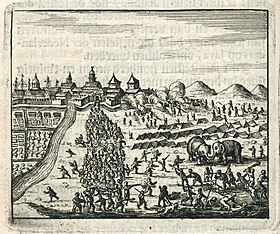Siege of Batavia
| Siege of Batavia | |||||||
|---|---|---|---|---|---|---|---|
 Siege of Batavia by Sultan Agung in 1628 |
|||||||
|
|||||||
| Belligerents | |||||||
|
|
|
||||||
| Commanders and leaders | |||||||
| Sultan Agung of Mataram | Jan Pieterszoon Coen | ||||||
| Strength | |||||||
| 10,000 (first siege) 14,000 (second siege) |
530 (first siege) ? (second siege) |
||||||
Dutch victory
Siege of Batavia was a military campaign led by Sultan Agung of Mataram to capture the Dutch port-settlement of Batavia in Java. The first attempt was launched in 1628, and the second in 1629, both were unsuccessful. Jan Pieterszoon Coen, the Governor-General of the Dutch East Indies managed to repel the sieges and beat off all of Sultan Agung's attacks.
In the Indonesian Archipelago the Dutch East Indies Company (VOC) first established their base of operation in Ambon. To expand their trading network, the Dutch asked for the permission of the Sultanate of Mataram, then the rising power in Java, to build lojis (trading posts, most consisting of a fort and warehouses) along Java's northern coast. The second ruler of Mataram, Raden Mas Jolang, allowed one such settlement to be built in Jepara in 1613, perhaps in hope that the company will be a powerful ally against his most powerful enemy, the city state of Surabaya.
After the VOC under their most renowned governor general Jan Pieterszoon Coen had wrested the port of Jacatra (Jayakarta) from Sultanate of Banten in 1619, they established a town that would serve as the Company's headquarter in Asia for the next three centuries. As part of the Company's security policy the Javanese people were made to feel unwelcome in Batavia, as the Dutch feared an uprising should they formed the majority of the city's population. To meet labor needs, Batavia instead imported large numbers of workers and slaves from other parts of the archipelago, such as the Maluku Islands and Bali. Notable among these attempts were Willem Ysbrandtszoon Bontekoe voyage to bring 1,000 Chinese immigrants to Batavia from Macao; however, only a small fraction of the 1,000 survived the trip. In 1621, another attempt was initiated and 15,000 people were deported from the Banda Islands to Batavia; on this occasion, only 600 survived the trip.
...
Wikipedia
